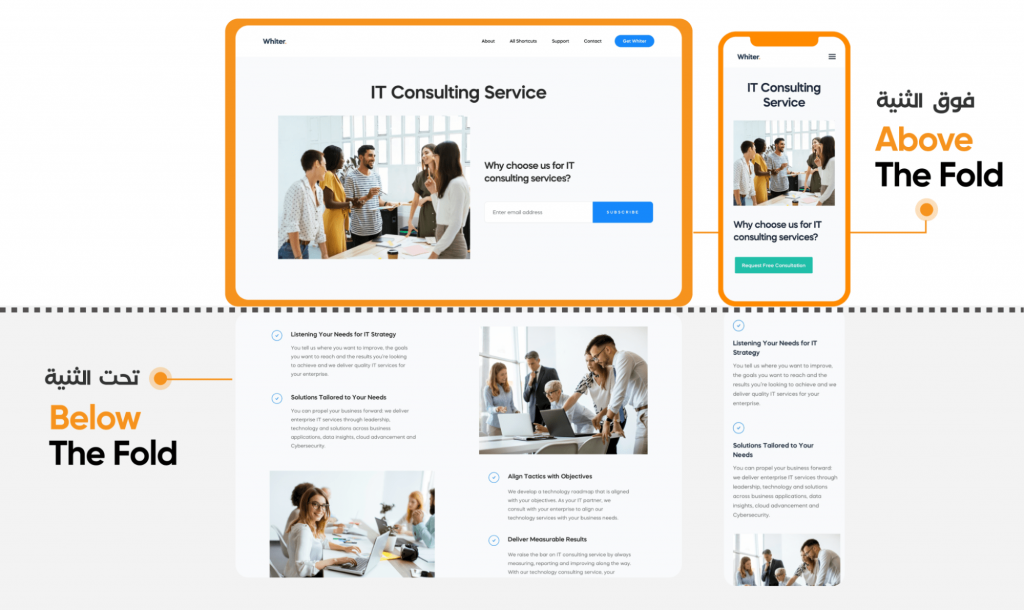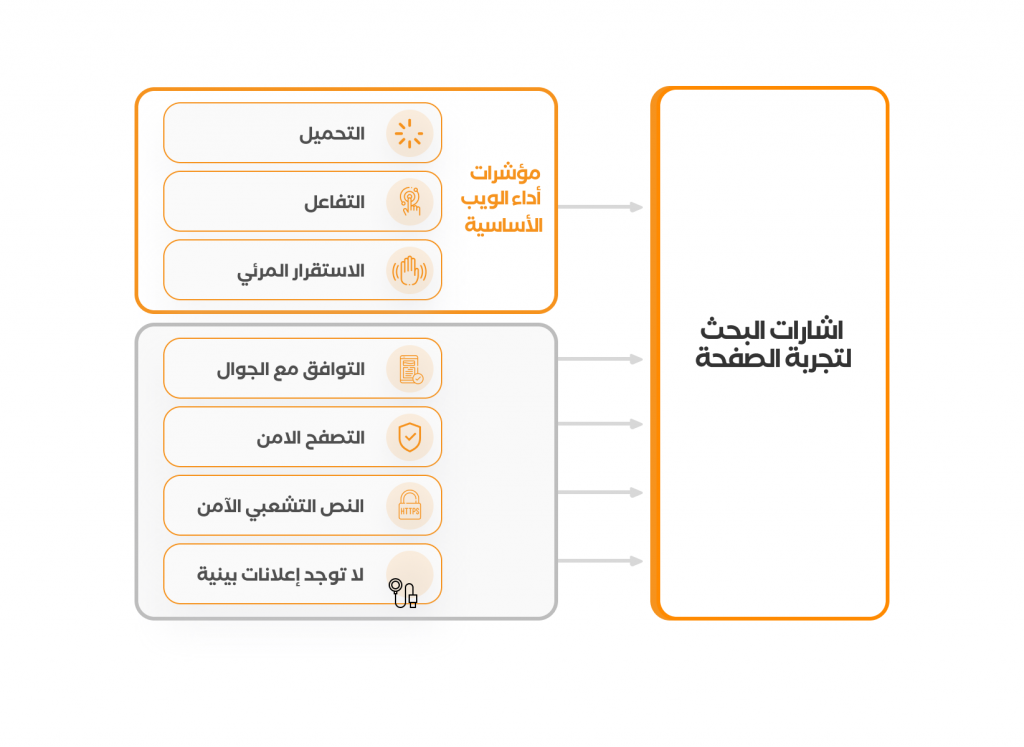Everything you need to know about updating Page Experience from Google, and how your site qualifies for it
Google recently revealed its update called Page Experience, which is expected to be launched in mid-June. As expected, these updates may greatly impact online businesses, as they often lead to a noticeable shift in the ranking of search results and the flow of visitors to your site from Google. In the event that the Page Experience update is completed, Google will aim to reward sites that provide its users and visitors with an enjoyable and useful experience, and these sites will have an advantage in topping the search results on Google and thus obtaining a greater number of visits.
The question is: How will Google do this?
All of this will be based on Core Web Vitals, which is a set of standards that measure your site’s performance from a user experience perspective, such as loading speed, visitors’ interaction with the page, etc.
But what are the core web performance indicators (Core Web Vitals) that Google will rely on in its measurements for any site in the next update?
There are three main indicators of basic web performance

Let us now learn more in detail about the three basic web performance indicators:
Download Largest Contentful Paint (LCP):
This indicator measures the time required to load the main content of the page (or everything that appears on the page before the visitor interacts or above the fold), and the “LCP” system quickly provides people with the information they require to ensure a good user experience, unlike slow loading speed, which is considered an unpleasant experience. Good for the user when searching for information.

What is the speed of loading the main content of the page “LCP” that is considered good?
In order to provide a good user experience, the LCP should occur within 2.5 seconds of the page start time to load or less. Poor user experience is defined by an LCP speed of 4.0 seconds or more. If the LCP speed ranges between 2.5 seconds and 4.0 seconds, this is considered a user experience that needs improvement.
How can you know the speed of loading the main content of the “LCP” page of your site?
The easiest way is to use the PageSpeed Insights tool from Google to measure the loading speed of your site's pages and get suggestions for improving loading speed and performance. To obtain a more accurate report on the speed of loading the main content of the page “LCP”, you can use the Core Web Vitals report in Google Search Console, where it will show you the performance of all pages of your site, grouped and classified according to status (good, needs improvement, or poor).
How can you improve the speed of loading the main content of your site’s “LCP” page?
Avoid using large images: Large images take time to load. It is preferable to use medium and small-sized images. Compress your site's resources: Ask the site developer to compress all the site's files, such as: CSS and Javascript files, as this reduces pressure on the server and speeds up page loading. Interaction (First Input Delay (FID): It is a measure that monitors the user’s first impression of the speed of the site’s interaction and response to any event (for example: clicking on a link, pressing a button, or the like). More precisely, FID measures the time period that takes from the user’s first interaction with the page until the time in which the browser is actually able to respond to that interaction.Slow interaction times and high FID scores may prevent users from completing actions such as purchasing, logging in, or clicking links.
What FID measurement speed is considered good?
To achieve a good user experience, your site pages should have a FID speed of less than 100 milliseconds. Conversely, poor user experience is defined by a FID speed of up to 300 milliseconds, or more than a third of a second. As for the “FID” speed between 100 ms and 300 ms, it is a user experience that needs improvement.
How can you know the “FID” speed of your site?
Since FID is a metric calculated when a user interacts with site elements, user interaction with the page is required to measure FID speed. However, the Event Timing API can measure the FID speed of a visitor's interaction with the site.
How can you improve the speed at which the entire page appears before the visitor (FID) of your site?
You can reduce FID through a number of improvements:
Put your ads in front of millions of readers. Join Jubna today- Defer unused JavaScript: If you are using a modern version of JavaScript, configure ES6 modules to load on demand.
- Check third-party code: Chances are, you'll find third-party code on your page that you don't need to turn on right away. Prioritize uploading what you think provides the most value to users.
- Keep the number of requests low and data transfer sizes small.
Cumulative Layout Shift (CLS):
It measures the visual stability of your website pages. To provide a good user experience, pages must maintain a “CLS” of less than 0.1, meaning that the page is very stable in front of the visitor. A high CLS duration may indicate sudden shifts in content, which may lead to a poor user experience such as clicking on a link by mistake that leads the user to move to another page unintentionally.
What is the duration of visual stabilization (CLS) that is considered good?
To provide a good user experience, the CLS score must be 0.1 or less. An unacceptable user experience is defined by a CLS score of 0.25 or greater. Any CLS score between 0.1 and 0.25 is a user experience that needs improvement.
How can you know the CLS duration of your site?
Fortunately, Google provides easy to understand CLS scores with PageSpeed Insights.
How can you improve your site's CLS?
Visual stability issues may include things like limiting image dimensions, assigning a fixed space for ads, or inserting unwanted dynamic ads on top of existing content. If you identify and resolve these issues that negatively affect the visual stability of your site, your CLS will improve. After we learned in detail about the three indicators of web performance and how to deal with each of them, it may seem a little confusing to you and you wonder how these elements affect the user experience, but simply put, the three elements are related and fundamentally affect the speed of loading the site and how quickly the visitor starts interacting with it. Website pages thus affect the user experience, and accordingly, Google determines whether the user experience on your site is good, bad, or needs improvement.
If you look at the following image you will see how Google suggests integrating these core web vitals with page experience signals:

1- Make sure that your site is compatible with all mobile devices:
Google cares a lot about mobile users, as more than 62% of Internet users use mobile phones. Therefore, your site must be responsive to all screens of mobile devices such as mobile phones and iPads. As Google's Page Experience update gives priority to this matter, if your site is not responsive to all screen sizes, it will reflect negatively on the user experience and on your appearance in search results.
2- Go to the secure hypertext transfer protocol (Https):
You should respect the privacy of your site visitors, and not store any data related to them without their permission, especially personal data such as address, name, or financial data. Site security is one of the key factors in evaluating user experience. If your site is still running the Hypertext Transfer Protocol (http), it is time to move to the secure Hypertext Transfer Protocol (https), which is more secure, because it encrypts the data transferred from the server to the browser and vice versa. This is why Google prefers it and considers it one of the factors that affect the user experience.
3-Safe browsing:
The latest update from Google aims to evaluate sites in terms of providing the best experience for users, including protecting their information online. Therefore, safe browsing is one of the most important features of this update, which will determine how secure your site is for all visitors and affect your ranking in search engines. Check Google Search Console to determine if your site has any security issues. You can find this information in the left navigation pane under “Manual Actions & Security.” Once the issues are fixed, click “Request Review” to inform Google that you have taken action to improve the security of your site.
4- Avoid intrusive and annoying ads:
To ensure that the user reaches the main content, you must avoid a large number of annoying advertisements and advertisements that cover the entire page or try to trick visitors into clicking on them by mistake. Therefore, there must be a balance in the quantity and quality of advertisements so as not to cause inconvenience to the user.
5- Paying attention to the quality of the content:
Appropriate content length and quality are factors that affect user experience. If you aspire to be at the top of the search results by writing an article that contains more than 2000 words and does not provide information or benefit to the reader, then this will be useless. In other words, Google aims to deliver the useful information that users of its search engine are searching for with ease. If an article that talks about a topic and in 600 words is able to deliver the information to the user in a good way and better than an article with 1000 words, then Google will upload the article that contains 600 words. A word to the top of the search results, because it makes the user find exactly what he was looking for easily. Google calculates the quality of the article through several factors, including: the user’s interaction with the article, whether by publishing, sharing, or commenting.
Are you ready to receive the Google Page Experience update? If your answer is no, now is the right time to work on your site, to achieve an ideal user experience free of hassle.